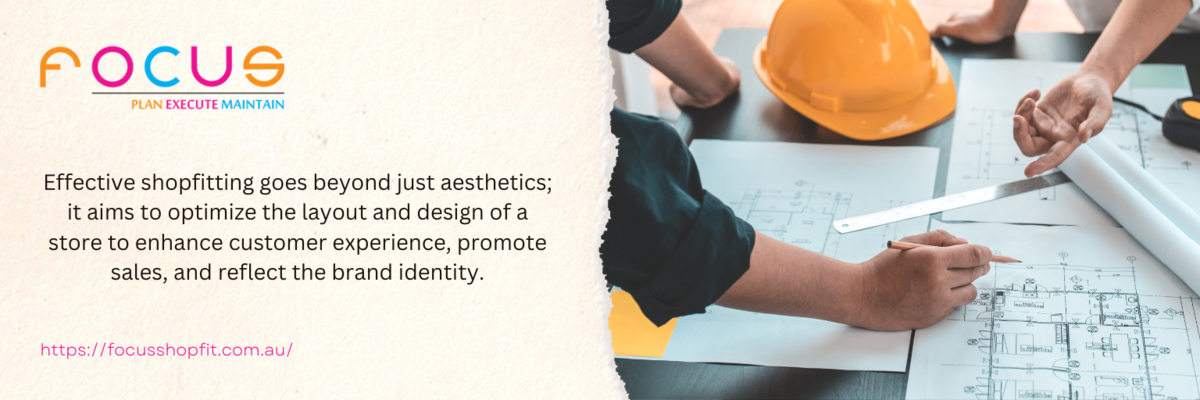Shopfitting is a crucial aspect of establishing a successful retail business in Australia. It involves the design, construction, and installation of fixtures, fittings, and equipment to create an attractive and functional retail space. Effective shopfitting goes beyond just aesthetics; it aims to optimize the layout and design of a store to enhance customer experience, promote sales, and reflect the brand identity. This article explores the importance of effective shopfitting, the latest trends in Australia, and the process of a retail fit-out, and provides valuable tips for both small business owners and larger enterprises.

The Importance of Effective Shopfitting
Effective shopfitting plays a fundamental role in the success of a retail business. It creates a visually appealing environment that attracts customers and encourages them to explore the store further. A well-designed shopfitting layout optimizes the use of space, ensuring that products are displayed in an organized and accessible manner. This enhances the overall shopping experience for customers, making them more likely to make a purchase and return for future visits.
Furthermore, effective shopfitting helps to establish the brand identity and personality of a business. Through thoughtful design choices, the shopfitting can convey the values, style, and ethos of the brand, creating a cohesive and memorable shopping experience. This is particularly important in a competitive market like Australia, where consumers are increasingly seeking unique and immersive retail experiences.
Choosing the Right Shopfitter for Your Business
Selecting the right shopfitter is crucial for the success of your retail business. It is important to consider their experience, expertise, and portfolio of previous projects. Look for a shopfitter who understands your brand identity and can translate it into a visually compelling store design. Additionally, ensure that they have a strong understanding of the retail industry in Australia and are up-to-date with the latest shopfitting trends.
Communication is key when working with a shopfitter. It is essential to have a clear and open line of communication to discuss your requirements, timelines, and budget constraints. A professional shopfitter should be able to provide detailed plans, 3D renderings, and cost estimates to give you a comprehensive understanding of the project scope.
The Process of a Retail Fit-Out
A retail fit-out involves several stages, from the initial concept design to the final installation. It typically begins with a thorough analysis of the retail space, including measurements, existing fixtures, and infrastructure. This is followed by the creation of a design concept that aligns with the brand and business objectives. The shopfitter will then develop detailed plans, including floor layouts, lighting design, and fixture specifications.
Once the fit-out design is finalized, the construction phase begins. This involves the fabrication of fixtures, installation of electrical and plumbing systems, and the construction of walls, ceilings, and flooring. The shopfitter manages the entire process, ensuring that the project progresses smoothly and adheres to the agreed-upon timeline.
After the construction is completed, the shopfitting company will conduct a thorough inspection to ensure that everything is in place and functioning correctly. They will make any necessary adjustments and provide training on the operation and maintenance of the shopfitting elements. Finally, the shopfitter will hand over the completed retail space to the business owner, ready for operation.

Elements of Effective Shopfitting
Effective shopfitting involves a careful consideration of various elements to create a cohesive and functional retail space. Lighting plays an essential role in setting the mood and highlighting products in your store. The use of different lighting techniques, such as ambient, accent, and task lighting, can create an inviting and visually appealing atmosphere.
Another essential element is the use of fixtures and fittings. These include shelving, display units, and racks that allow for the effective presentation of products. The shopfitter will consider factors such as product visibility, accessibility, and space optimization when designing the layout of fixtures.
The choice of materials and finishes also contributes to effective shopfitting. High-quality materials enhance the aesthetic and ensure the durability and longevity of your store. From flooring options to wall finishes, selecting materials that align with the brand and the desired shopping experience is crucial.
Shopfitting Materials and Finishes
In Australia, shopfitters have access to a wide range of materials and finishes to suit different retail concepts and budgets. Timber is a popular choice for its warm and natural appeal. It can be used for flooring, display units, and even feature walls. Metal finishes, such as stainless steel and brass, provide a modern and industrial look. They are often used for fixtures and fittings, adding a touch of sophistication to the retail space.
When it comes to flooring, options range from polished concrete for a contemporary feel to luxurious carpets for a more upscale environment. The selection of wall finishes varies from paint and wallpaper to textured panels and decorative cladding. Each material and finish choice should be carefully considered to create a cohesive and visually pleasing shopfitting design.
Shopfitting Tips for Small Businesses
Effective shopfitting is not limited to large retail chains; small businesses can also create impactful and inviting retail spaces. Here are some tips for small business owners:
- Define your brand identity: Understand your brand’s values, target audience, and unique selling points. This will guide your shopfitting choices and ensure consistency throughout the store.
- Optimize the use of space: Small retail spaces require efficient use of every square foot. Consider versatile fixtures, such as modular shelving and adjustable display units, to maximize product visibility.
- Create focal points: Draw attention to key products or promotions by creating eye-catching displays or feature walls. This will capture customers’ attention and encourage them to explore further.
- Pay attention to signage: Clear and well-designed signage helps customers navigate your store and find what they are looking for. Use consistent branding and legible fonts to ensure a cohesive visual identity.
- Keep it organized: A cluttered or disorganized store can deter customers. Regularly evaluate your shopfitting layout to ensure products are organized, shelves are well-stocked, and the space is tidy.
Hiring a Professional Shopfitting Company
For businesses seeking a seamless and professional shopfitting experience, it is essential to hire a reputable shopfitting company. Choose a shopfitting company with a proven track record, positive testimonials from previous clients, and a portfolio that aligns with your vision. Request detailed proposals and cost estimates from multiple companies to ensure you find the best fit for your business.
When hiring a shopfitting company, consider their expertise in retail fit-outs, knowledge of Australian regulations and standards, and ability to meet deadlines. A professional shopfitter will provide a comprehensive service, from concept design to final installation, ensuring that your retail space is transformed into a visually appealing and functional environment.

Effective shopfitting is a critical factor in the success of any retail business in Australia. It goes beyond aesthetics and aims to create a visually appealing and functional retail space that enhances the customer experience and reflects the brand identity. By understanding the importance of effective shopfitting, staying informed about the latest trends, and hiring a professional shopfitting company, businesses can create memorable and profitable retail environments. Whether you are a small business owner or part of a larger enterprise, investing in effective shopfitting is an investment in the future success of your business.
